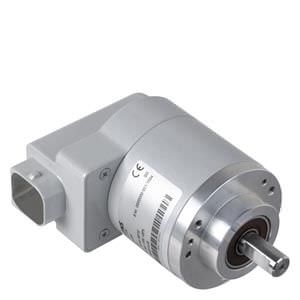Absolute encoder with DRIVE-CLiQ Siemens

Функции
DRIVE-CLiQ absolute encoder
Absolute encoders (absolute shaft encoders) are designed on the same scanning principle as incremental encoders, but have a greater number of tracks. For example, if there are 13 tracks, then 213 = 8192 steps are coded in the case of single-turn encoders.
The code used is a one-step code (gray code), which prevents any scanning errors from occurring.
After switching on the machine, the position value is transmitted immediately to the controller. There is no need for homing.
Single-turn encoders
Single-turn encoders divide one revolution (360 degrees mechanical) into a specific number of steps, e.g. 8192. A unique code word is assigned to each position. After 360 degress the position values are repeated.
Multi-turn encoders
Multi-turn encoders also record the number of revolutions, in addition to the absolute position within one revolution. To do this, further code discs which are coupled via gear steps with the encoder shaft are scanned. When evaluating 12 additional tracks, this means that 212 = 4096 revolutions can be coded.
Технические данные
Product name | Absolute encoder with DRIVE‑CLiQ |
|---|---|
| 6FX2001‑5.D..‑0AA1 |
Operating voltage Vp on encoder | 24 V DC -15 % +20 % |
Current consumption, approx. | |
| 245 mA |
| 325 mA |
Interface | DRIVE‑CLiQ |
Data output | DRIVE‑CLiQ |
Short‑circuit strength | Yes |
Transmission rate | 100 Mbit |
Speed, max. | |
| 14000 rpm |
| |
| 12000 rpm |
| 10000 rpm |
Cable length to downstream electronics, max.1) | 100 m (328 ft) |
Connection | DRIVE‑CLiQ connector, radial |
Resolution | |
| 22 bit |
| 34 bit |
Incremental track | 2048 S/R, 1 Vpp |
Code type | |
| Gray |
| DRIVE‑CLiQ |
Parameterization capability | |
| Yes |
Accuracy | ± 36 arcsec |
Friction torque (at 20 °C) (68 °F) | ≤ 0.01 Nm (0.09 lbf‑in) |
Starting torque (at 20 °C) (68 °F) | ≤ 0.01 Nm (0.09 lbf‑in) |
Shaft loading capacity | |
| |
| 40 N (8.99 lbf) |
| 60 N (13.5 lbf) |
| |
| 10 N (2.25 lbf) |
| 20 N (4.50 lbf) |
Shaft diameter | |
| 6 mm (0.24 in) |
| 10 mm (0.39 in) |
| 10 mm/12 mm (0.39 in/0.47 in) |
Shaft length | |
| 10 mm (0.39 in) |
| 20 mm (0.79 in) |
Angular acceleration, max. | 105 rad/s2 |
Moment of inertia of rotor | |
| 1.90 × 10-6 kgm2 |
| 2.80 × 10-6 kgm2 |
Vibration (55 ... 2000 Hz) in accordance with EN 60068‑2‑6 | ≤ 100 m/s2 (328 ft/s2) |
Shock in accordance with EN 60068‑2‑27 | |
| ≤ 2000 m/s2 (6562 ft/s2) |
| ≤ 1000 m/s2 (3281 ft/s2) |
Degree of protection acc. to EN 60529 (IEC 60529) | |
| IP67 |
| IP64 |
Ambient temperature | |
| ‑20 ... +100 °C (‑4 … +212 °F) |
Weight, approx. | |
| 0.4 kg (0.88 lb) |
| 0.5 kg (1.10 lb) |
EMC | Tested in accordance |
Approvals, according to | CE, cULus |
S/R = signals/revolution
1) Observe the maximum permissible cable length of the connected module.







 Ответ от производителя может занять до 5 дней и более.
Ответ от производителя может занять до 5 дней и более.

